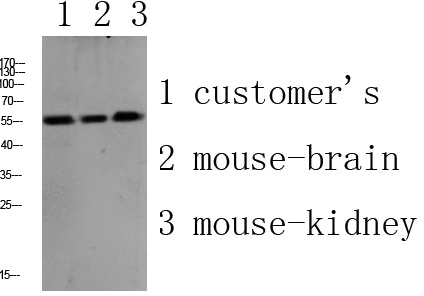
| WB | 咨询技术 | Human,Mouse,Rat |
| IF | 咨询技术 | Human,Mouse,Rat |
| IHC | 咨询技术 | Human,Mouse,Rat |
| ICC | 技术咨询 | Human,Mouse,Rat |
| FCM | 咨询技术 | Human,Mouse,Rat |
| Elisa | 1/10000 | Human,Mouse,Rat |
| Aliases | Phospholipase D4 (PLD 4; EC 3.1.4.4; Choline phosphatase 4; Phosphatidylcholine-hydrolyzing phospholipase D4) |
| Entrez GeneID | 122618 |
| WB Predicted band size | Calculated MW: 56 kDa; Observed MW: 56 kDa |
| Host/Isotype | Rabbit IgG |
| Antibody Type | Primary antibody |
| Storage | Store at 4°C short term. Aliquot and store at -20°C long term. Avoid freeze/thaw cycles. |
| Species Reactivity | Human,Mouse,Rat |
| Immunogen | Synthesized peptide derived from human PLD4 Polyclonal |
| Formulation | Purified antibody in PBS with 0.05% sodium azide,0.5%BSA and 50% glycerol. |
+ +
以下是关于PLD4抗体的3篇代表性文献的简要整理:
---
1. **文献名称**:*Autoantibodies against Phospholipase D4 in Systemic Sclerosis*
**作者**:Yoshifuji H, et al.
**摘要**:本研究首次报道系统性硬化症(SSc)患者血清中存在抗PLD4自身抗体,提示其可能参与疾病病理过程。抗体阳性与肺纤维化等临床表现相关,为SSc的血清学标志物研究提供了新方向。
---
2. **文献名称**:*Structural and functional characterization of PLD4 as a lysosomal exonucleases*
**作者**:Ito Y, et al.
**摘要**:通过X射线晶体学解析PLD4蛋白结构,揭示其核酸外切酶活性依赖的免疫功能。研究利用PLD4特异性抗体验证其在溶酶体中的定位,为理解PLD4在免疫调控中的作用提供分子基础。
---
3. **文献名称**:*PLD4 as a novel susceptibility gene for rheumatoid arthritis*
**作者**:Terao C, et al.
**摘要**:全基因组关联分析发现PLD4基因多态性与类风湿关节炎(RA)易感性相关。实验通过抗PLD4抗体检测患者外周血单核细胞中PLD4表达水平,提示其可能通过调控炎症通路参与RA发病机制。
---
**备注**:PLD4抗体研究目前多集中于自身免疫疾病领域,涉及诊断标志物探索或功能机制解析。如需具体实验应用类文献(如抗体开发),建议补充关键词进一步筛选。
Phospholipase D4 (PLD4) is a member of the phospholipase D family, which catalyzes the hydrolysis of phospholipids to generate phosphatidic acid, a lipid mediator involved in cellular signaling, membrane trafficking, and cytoskeletal reorganization. Unlike its well-studied isoforms PLD1 and PLD2. PLD4 remains less characterized. It is a type II transmembrane protein predominantly expressed in immune cells, including macrophages and dendritic cells, and is implicated in lysosomal and autophagic processes. PLD4 has garnered attention due to its potential role in immune regulation and disease pathogenesis. Studies suggest it may function as a 5’-exonuclease, degrading single-stranded DNA, which could modulate immune responses by clearing nucleic acid debris or inhibiting inflammatory signaling.
PLD4 antibodies are essential tools for investigating its expression, localization, and function. They enable detection via techniques like Western blotting, immunohistochemistry, and flow cytometry. Research has linked PLD4 dysregulation to autoimmune disorders (e.g., systemic sclerosis) and cancers, where altered PLD4 expression may influence tumor progression or immune evasion. Recent interest also stems from genome-wide association studies identifying PLD4 variants associated with rheumatoid arthritis and lupus, hinting at its therapeutic or diagnostic potential. However, the precise mechanisms of PLD4 in health and disease remain unclear, necessitating further studies using validated antibodies to unravel its biological and clinical significance.
×